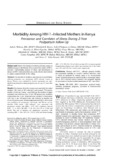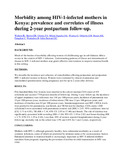| dc.contributor.advisor | | |
| dc.contributor.author | Walson, Judd L | |
| dc.contributor.author | Brown, Elizabeth R | |
| dc.contributor.author | Otieno, Phelgona A | |
| dc.contributor.author | Mbori-Ngacha, DA | |
| dc.contributor.author | Wariua, Grace | |
| dc.contributor.author | Obimbo, Elizabeth M | |
| dc.contributor.author | Bosire, Rose K | |
| dc.contributor.author | Farquhar, Carey | |
| dc.contributor.author | Wamalwa, Dalton | |
| dc.contributor.author | John-Stewart, Grace C | |
| dc.date.accessioned | 2013-02-26T12:56:44Z | |
| dc.date.issued | 2007 | |
| dc.identifier.citation | J. Acquir Immune Defic Syndr | en |
| dc.identifier.uri | http://erepository.uonbi.ac.ke:8080/xmlui/handle/123456789/11828 | |
| dc.identifier.uri | http://www.ncbi.nlm.nih.gov/pubmed/17667334 | |
| dc.identifier.uri | http://www.ncbi.nlm.nih.gov/pmc/articles/PMC3372412/ | |
| dc.description.abstract | Background: Much of the burden of morbidity affecting women of
childbearing age in sub-Saharan Africa occurs in the context of HIV-1
infection. Understanding patterns of illness and determinants of
disease in HIV-1–infected mothers may guide effective interventions
to improve maternal health in this setting.
Methods: We describe the incidence and cofactors of comorbidities
affecting peripartum and postpartum HIV-1–infected women in
Kenya. Women were evaluated by clinical examination and standardized
questionnaires during pregnancy and for up to 2 years after
delivery.
Results: Five hundred thirty-five women were enrolled in the cohort
(median CD4 count of 433 cells/mm3) and accrued 7736 personmonths
of follow-up. During 1-year follow-up, the incidence of upper
respiratory tract infections was 161 per 100 person-years, incidence
of pneumonia was 33 per 100 person-years, incidence of tuberculosis
(TB) was 11 per 100 person-years, and incidence of diarrhea was
63 per 100 person-years. Immunosuppression and HIV-1 RNA levels
were predictive for pneumonia, oral thrush, and TB but not for
diarrhea; CD4 counts ,200 cells/mm3 were associated with
pneumonia (relative risk [RR] = 2.87, 95% confidence interval
[CI]: 1.71 to 4.83), TB (RR = 7.14, 95% CI: 2.93 to 17.40) and
thrush. The risk of diarrhea was significantly associated with
crowding (RR = 1.86, 95% CI: 1.19 to 2.92) and breast-feeding
(RR = 1.71, 95% CI: 1.19 to 2.44). Less than 10% of women reported
hospitalization during 2-year follow-up; mortality risk in the cohort
was 1.9% and 4.8% for 1 and 2 years, respectively.
Conclusions: Mothers with HIV-1, although generally healthy,
have substantial morbidity as a result of common infections, some
of which are predicted by immune status or by socioeconomic
factors. Enhanced attention to maternal health is increasingly important
as HIV-1–infected mothers transition from programs targeting
the prevention of mother-to-child transmission to HIV care clinics. | en |
| dc.language.iso | en | en |
| dc.relation.ispartofseries | 46:208–215; | |
| dc.subject | HIV/AIDS, HIV-1 progression, maternal health, morbidity, postpartum, pregnancy, prevention of mother-to-childtransmission, women | en |
| dc.title | Morbidity among HIV-1–infected mothers in Kenya prevalence and correlates of illness during 2-year postpartum follow-up | en |
| dc.type | Article | en |
| local.publisher | Department of Pediatrics, University of Nairobi, Nairobi, | en |


